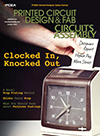Products
Christopher Associates announced significant breakthroughs in performance of the NSpec AOI system. With a universal data converter, an enhanced and extensive parts library, and significant performance improvements, programming/debugging time has been reduced by 50% or more depending upon program specifics. Inspection speeds have improved and defect detection capabilities have also been enhanced. The programming speed improvement can be applied to all 3,500 NSpec systems in the field by a simple software update.
Using LED lighting and a telecentric lens with a high resolution color camera, the latest model, the DL, can inspect components, solder joints, full color inspection, 2-D solder paste, text, and 01005 components.
Christopher Associates Inc., christopherweb.com
Using LED lighting and a telecentric lens with a high resolution color camera, the latest model, the DL, can inspect components, solder joints, full color inspection, 2-D solder paste, text, and 01005 components.
Christopher Associates Inc., christopherweb.com
Thermo Electron’s NITON Analyzers business unit has released new software with additional features and benefits to assist with RoHS compliance.
NITON Analyzers are portable x-ray fluorescence (XRF) instruments for on-site, nondestructive RoHS screening. Used for testing of polymers, solders and electronic components for RoHS, ELV and WEEE compliance verification screening. Supply easy-to-use and reliable onsite screening and material analysis.
Version 5.1 analyzer software includes an advanced thickness correction for improved direct analysis of polymer materials. For several years, the RoHS analyzers have been used to quantify
restricted elements in plastic matrices down to 5 mm thickness. However, though semi-quantitative testing was done directly, very thin samples typically required folding or layering in order to provide the best analytical results possible. The Thickness Correction algorithm provides the ability to compensate test results for even ultra-thin plastic materials. Is straightforward and easy-to-use.
The new software features six language options, improved analytical accuracy and element additions to already extensive calibration matrices.
Version 5.1 is currently shipping on all new instruments, and is a free upgrade to customers with existing compatible analyzers.
NITON Analyzers are portable x-ray fluorescence (XRF) instruments for on-site, nondestructive RoHS screening. Used for testing of polymers, solders and electronic components for RoHS, ELV and WEEE compliance verification screening. Supply easy-to-use and reliable onsite screening and material analysis.
Version 5.1 analyzer software includes an advanced thickness correction for improved direct analysis of polymer materials. For several years, the RoHS analyzers have been used to quantify
restricted elements in plastic matrices down to 5 mm thickness. However, though semi-quantitative testing was done directly, very thin samples typically required folding or layering in order to provide the best analytical results possible. The Thickness Correction algorithm provides the ability to compensate test results for even ultra-thin plastic materials. Is straightforward and easy-to-use.
The new software features six language options, improved analytical accuracy and element additions to already extensive calibration matrices.
Version 5.1 is currently shipping on all new instruments, and is a free upgrade to customers with existing compatible analyzers.
Thermo Electron Corp., thermo.com
SHELLCASE CF is a wafer-level technology for optical components integrated into electronic products such as miniaturized cameras in camera phones, digital still cameras and video camcorders.
Suitable for image sensors, certain types of MEMS and other optical devices, it protects components from contamination from the initial stage of processing and is compatible with conventional Chip-on-Board (COB) assembly processes.
An immediate application is for CMOS and CCD image sensors used in camera phones. Said to provide up to 40% improvement in yield over existing COB technology. This is realized through the protection of the sensor's active area from contamination and the ability to perform wafer-level image testing prior to module assembly, both of which improve camera module yield and reduce overall cost.
Uses existing wire-bond assembly infrastructure and processes, minimizing the hurdles to rapid adoption.
Unlike COB technology, it encapsulates the image sensor, MEMS or other optical device with a glass cover that is elevated from the silicon surface using cavity walls. The cover design leaves the image sensor bond pads exposed allowing for standard wire-bond assembly. The protected die is then singulated and mounted to the board using standard die attach processes. Provides the flexibility to perform optical testing at the most favorable point of the assembly flow, as defined by their specific requirements and manufacturing environment.
Tessera, tessera.com
SEMICON West, Booth 8622
Press Releases
- Aegis Software Expands its Presence in France and Partners with STPGroup
- Altus Adds Breakthrough Automated Inline Laser Depaneling System to its Line-Up
- Fuji America Promotes Chris Dayney to Technical Marketing Manager, Expanding Focus on Premium Technical Content
- BTU International Announces Strategic Manufacturing Expansion in Singapore to Strengthen Global Supply Chain


